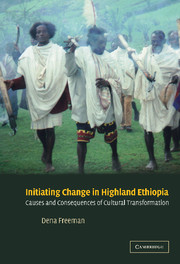Book contents
- Frontmatter
- Contents
- List of illustrations
- Acknowledgements
- Select glossary
- 1 Introduction: theorising change
- 2 The recent history of the Gamo Highlands
- 3 Production and reproduction
- 4 The sacrificial system
- 5 The initiatory system
- 6 Experiencing change
- 7 Assemblies and incremental cultural change
- 8 Transformation versus devolution: the organisational dynamics of change
- Notes
- Bibliography
- Index
2 - The recent history of the Gamo Highlands
Published online by Cambridge University Press: 22 September 2009
- Frontmatter
- Contents
- List of illustrations
- Acknowledgements
- Select glossary
- 1 Introduction: theorising change
- 2 The recent history of the Gamo Highlands
- 3 Production and reproduction
- 4 The sacrificial system
- 5 The initiatory system
- 6 Experiencing change
- 7 Assemblies and incremental cultural change
- 8 Transformation versus devolution: the organisational dynamics of change
- Notes
- Bibliography
- Index
Summary
A good starting point for our exploration of the dynamics of cultural change in the Gamo Highlands is to look at some of the large-scale historical changes that were going on in Ethiopia during the nineteenth and twentieth centuries. The nineteenth century saw the increasing involvement of the Horn of Africa in the slave trade and the expansion of the Abyssinian empire southwards towards the vicinity of the Gamo Highlands. This expansion eventually culminated in the establishment of the nation state of Ethiopia at the turn of the century. Since then Ethiopia has seen the development of first a national currency and then taxation, the opening up of new trade and transport opportunities through the increasing use of motorised vehicles, the spread of Protestant ideology by European and North American missionaries, a revolution that brought Marxism to even the remotest parts of the country and, most recently, a new government that has reorganised the country as a federal Republic along ethnic lines.
The nineteenth century: slaves, warfare and internal flux
During the nineteenth century much of the Horn of Africa was involved in the Red Sea Trade. Trade routes extended from the Gulf of Aden port of Zeila southwards through the centre of the Amhara empire and on towards the ‘savage’ lands of the south. With the exception of only a few periods when political disruption made travel to the south unsafe, merchant caravans had traversed these routes since at least the first century AD.
- Type
- Chapter
- Information
- Initiating Change in Highland EthiopiaCauses and Consequences of Cultural Transformation, pp. 28 - 46Publisher: Cambridge University PressPrint publication year: 2002



